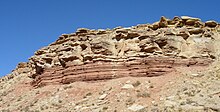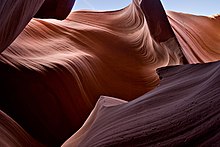Sedimentology
Sedimentology is the study of sediments such as sand,[1] mud (silt),[2] and clay.[3] How they are laid down today is used to understand how rocks were formed.[4] A person who studied sedimentology is called Sedimentologist. They use their understanding of modern processes to interpret sedimentary rocks and sedimentary structures.[5]


Sedimentary rocks cover most of the Earth's surface, record much of the Earth's history, and contain the fossil record. Sedimentology is closely linked to stratigraphy, which is the study of the physical and temporal (time) relationships between rock layers or strata.
The idea that the processes affecting the earth today are the same as in the past is called uniformitarianism. It is the basis for finding out how sedimentary features in the rock record were formed. By comparing similar features today to features in the rock record—for example, by comparing modern sand dunes to dunes preserved in ancient aeolian sandstones—geologists reconstruct past environments.